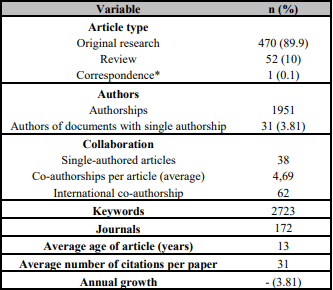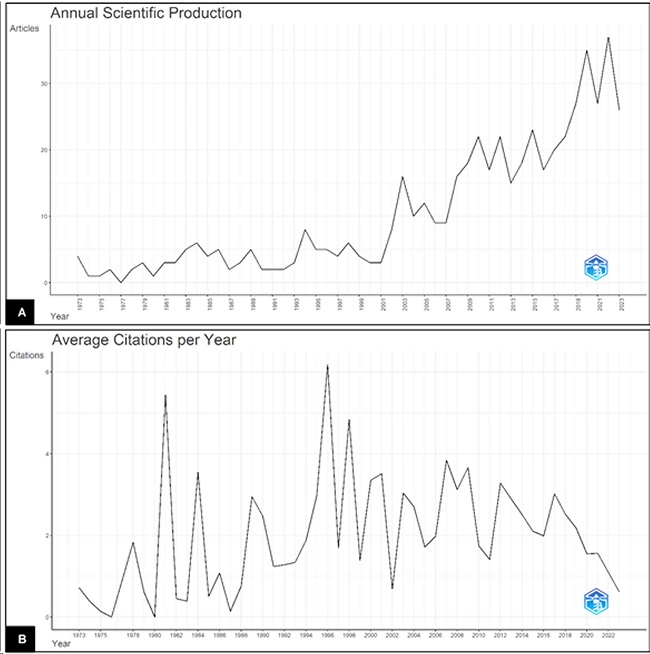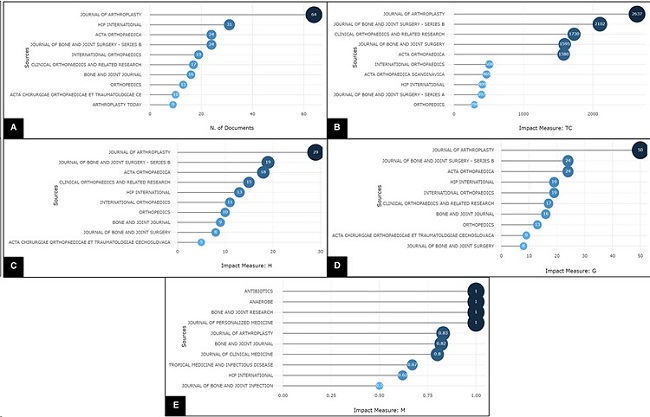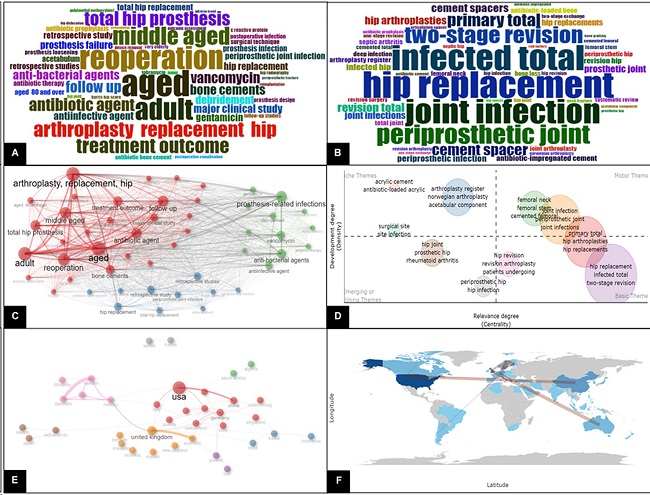1. INTRODUCTION
Hip fracture is a relatively common condition in healthcare practice, especially among older adults [1]. Considering the demographic transition occurring worldwide, this pathology is increasingly observed. Depending on the personalized approach and health phenotype of the patient, the decision to undergo surgical correction is determined [2]. Adverse events and post-intervention complications are some reasons why opting for arthroplasty may be avoided, as they significantly increase the need for reintervention, morbidity, mortality, and healthcare costs [2, 3]. Among these, infectious complications are often a significant cause in practice [4].
To address this difficulty, therapeutic tools for intraoperative use in orthopedics and traumatology have been designed, such as the use of antibiotic-loaded cement [5]. Previous evidence has suggested that using this technique has a prophylactic effect against periprosthetic joint infection, potentially improving the outcome significantly and counteracting the risk of infectious complications, even in high-risk individuals [6, 7]. Despite reports from various authors indicating its increasing use, approaches, gaps, pluralism, and research ideas associated with its use in hip arthroplasty are still unknown to date. This lack of knowledge hinders the identification of gaps and opportunities that need to be investigated, especially in regions of the world where scientific production on the topic has not been prominent.
In order to provide novel evidence on the evolution and patterns related to research in this topic, the aim of this study was to analyze the scientific growth, characteristics, and metrics of global and historical research on the use of antibiotic-loaded cement in hip arthroplasty.
2. MATERIAL AND METHODS
2.1. DESIGN AND DATA SOURCE
A cross-sectional bibliometric study was conducted using the Scopus database as the data source. It is the database with the largest amount of peer-reviewed literature globally, which is a main reason for choosing this database as previously described [8, 9].
2.2. DATA SEARCH
A search strategy based on Medical Subject Headings (MeSH) terms and synonyms was designed and structured to identify scientific articles related to the use of antibiotic-loaded cement in hip arthroplasty, regardless of the typology and research approach. Initially, a pilot test was conducted to confirm that the results obtained derived from the stated objective and strategy. After this test, the following search was employed: TITLE-ABS-KEY(“Hip Replacement Arthroplasties”) OR TITLE-ABS-KEY(“Hip Prosthesis Implantation”) OR TITLE-ABS-KEY(“Hip Prosthesis Implantations”) OR TITLE-ABS-KEY(“Hip Replacement Arthroplasty”) OR TITLE-ABS-KEY(“Total Hip Replacements”) OR TITLE-ABS-KEY(“Total Hip Replacement”) OR TITLE-ABS-KEY(“Total Hip Arthroplasty”) OR TITLE-ABS-KEY(“Total Hip Arthroplasties”) AND TITLE-ABS-KEY(“Anti Bacterial Agents”) OR TITLE-ABS-KEY(“Antibacterial Agents”) OR TITLE-ABS-KEY(“Antibacterial Agent”) OR TITLE-ABS-KEY(“Anti-Bacterial Compounds”) OR TITLE-ABS-KEY(“Anti Bacterial Compounds”) OR TITLE-ABS-KEY(“Anti-Bacterial Agent”) OR TITLE-ABS-KEY(“Anti Bacterial Agent”) OR TITLE-ABS-KEY(“Anti-Bacterial Compound”) OR TITLE-ABS-KEY(“Anti Bacterial Compound”) OR TITLE-ABS-KEY(“Bacteriocidal Agents”) OR TITLE-ABS-KEY(“Bacteriocidal Agent”) OR TITLE-ABS-KEY(“Bacteriocide”) OR TITLE-ABS-KEY(“Bacteriocides”) OR TITLE-ABS-KEY(“Anti-Mycobacterial Agents”) OR TITLE-ABS-KEY(“Anti Mycobacterial Agents”) OR TITLE-ABS-KEY(“Anti-Mycobacterial Agent”) OR TITLE-ABS-KEY(“Anti Mycobacterial Agent”) OR TITLE-ABS-KEY(“Antimycobacterial Agent”) OR TITLE-ABS-KEY(“Antimycobacterial Agents”) OR TITLE-ABS-KEY(“Antibiotics”) OR TITLE-ABS-KEY(“Antibiotic”) AND TITLE-ABS-KEY(“cement”).
As inclusion criteria, any peer-reviewed document published in a scientific journal was considered. Exclusions encompassed conference abstracts, errata, books, book chapters, among others, that did not follow the regular peer-review process. The search was executed on December 11, 2023, with results filtered by the labels "humans" and "journals." Considering the historical nature of the analysis, no specific time frame for article inclusion was defined.
2.3. DATA STANDARDIZATION
Following the above, data related to the domains of citation, bibliographic information, abstract, and keywords were exported in .CSV format for manual review and data standardization in Microsoft Office Excel 2016. Four authors conducted the review, eliminating documents unrelated to the topic based on title, abstract, and keywords. Subsequently, these authors manually reviewed the homogeneity of variables and data to avoid discrepancies in visual and bibliometric analysis. In the case of the manuscript typology variable, these were regrouped as follows: Original Articles (including any observational or experimental design with primary data or data reanalysis), Reviews (including narrative reviews, systematic reviews with or without meta-analysis, umbrella reviews, and scoping reviews), Case Reports (including both series and individual cases), and Correspondences (including letters to the editor, comments, editorials, correspondences per se, and other short manuscript typologies sharing structure and purpose).
2.4. STATISTICAL ANALYSIS
Once the data were standardized, visual, quantitative, and bibliometric analysis was conducted. Metrics and scientometric calculations were generated to assess the evolution, general characteristics, and impact of the global evidence on the use of antibiotic-loaded cement in hip arthroplasty. The bibliometrix package in R, which allows for the calculation of quantitative scientometric indicators and visualization of results (version 4.3.1) [10], was used for this analysis. Synonyms, errors, plurals, and variants were carefully grouped using a thesaurus to homogenize the analysis. Keywords, authors, and institutions were standardized accordingly.
Descriptive analysis and characterization of the scientific production were performed. Metrics such as h-index, g-index, and m-index were used to measure the impact of authors, institutions, and countries. Additionally, the frequency of cumulative citations was measured. Definitions and specifications for the use of these metrics in bibliometric studies have been previously described [11, 12]. Frequency and percentage calculations were carried out using Microsoft Office Excel 2016.
3. RESULTS
Initially, 576 documents were identified, of which 523 were selected following the application of inclusion and exclusion criteria, published between 1973 and 2023, establishing a 50-year research time frame. 89.9% (n=470) of the production corresponded to original articles, with an average of approximately five authors per article, and international collaboration accounted for 11.85%. The global average of citations received per document was 31, and the annual growth was 3.8% (Table 1). A sustained growth in publications on the use of antibiotic-loaded cement in hip arthroplasty was identified, with 2022 being the year with the highest production (Figure 1-A). In contrast to citations received over time, which have been fluctuating with an average below 10 (Figure 1-B). Applying Lotka's law, it was observed that 84.1% of the authors had published only one article, followed by 10.3% with two articles.
Table 1: Overview of the global research of antibiotic-loaded cement use in hip arthroplasty (n=523).

Includes letters to the editor, editorials, and comments.

Figure 1: Scientific evolution of research on the use of antibiotic-loaded cement in hip arthroplasty.A: Annual scientific production from 1973 to 2023. B: Average number of citations received per article per year.
When assessing the journals where these documents have been published, the Journal of Arthroplasty emerged as the source with the highest number of published documents (n=64) (Figure 2-A), total citations received (2637 citations) (Figure 2-B), and the highest impact obtained (both in h-index and g-index) (Figures 2 C-D). On the contrary, concerning the m-index, the highest value (m-index = 1) is shared by four journals (Figure 2-E).

Figure 2: Frequency and impact obtained by journals derived from publications on the use of antibiotic-loaded cement in hip arthroplasty.
Among the most prolific authors in the studied theme, Leif Ivar Havelin (affiliated with the Universitetet i Bergen, Norway) leads the list with 11 published documents. Additionally, he is the author with the highest number of citations, h-index, and g-index obtained. In terms of prolific affiliations, Haukeland University Hospital (located in Norway) leads, having published 18 documents to date and obtaining the highest h-index (although this last value has also been achieved by the Universitetet i Bergen). Despite this, the United States stands out as the most prolific and impactful country on the topic to date, with 143 published documents and an h-index of 46 (Table 2). Interestingly, Norway is not among the top five most prolific countries.
Table 2: Production and impact of authors, affiliations and most prolific countries on research on the use of antibiotic-loaded cement in hip arthroplasty.

When exploring trends and the most studied lines regarding the use of antibiotic-loaded cement in hip arthroplasty, it was observed that research has predominantly focused on adults or the elderly, with an emphasis on outcome evaluation (highlighting reoperation). Various antibiotic agents are assessed, and retrospective designs are frequently employed (Figure 3-A). Additionally, there has been a certain interest, represented by the frequency of keywords in the form of bigrams, in studies related to the evaluation of revision at two moments, outcomes in the periprosthetic joint, and cement spacer (Figure 3-B). This is evident in the co-occurrence of words in the structuring of topics through titles, where essentially three groups of networks represent the highest frequency of research in the field (Figure 3-C). An emerging theme is the inclusion of patients with rheumatoid arthritis in this research field (Figure 3-D).

Figure 3: Trends, topic co-occurrence, degree of topic development, and research collaboration on the use of antibiotic-loaded cement in hip arthroplasty.
Regarding the international collaboration network, it was identified that the United States and the United Kingdom lead each of their networks, both strongly linked with European and Asian countries (Figure 3-E). Chile was the only Latin American country identified with participation and/or collaboration in research on the analyzed topic (Figure 3-F).
Among the articles with the highest impact obtained to date, three original studies stand out: 1) "Management of deep infection of total hip replacement" (539 citations - The Journal of Bone & Joint Surgery British Volume – 1981 – DOI:10.1302/0301-620x.63b3.7021561) [13]; 2) "Antibiotic prophylaxis in total hip arthroplasty: Effects of antibiotic prophylaxis systemically and in bone cement on the revision rate of 22,170 primary hip replacements followed 0-14 years in the Norwegian Arthroplasty Register" (323 citations - Acta Orthopaedica Scandinavica – 2003 – DOI: 10.1080/00016470310018135) [14]; and 3) "Long-term elution of antibiotics from bone-cement: An in vivo study using the prosthesis of antibiotic-loaded acrylic cement (PROSTALAC) system" (294 citations – The Journal of Arthroplasty – 1998 – DOI: 10.1016/S0883-5265c64616 5403(98)90179-6) [15].
4. DISCUSSION
This study provides, for the first time, an overview of the global research landscape on the use of antibiotic-loaded cement in hip arthroplasty. In general, a sustained growth in publication volume has been identified since the 1970s, albeit with a relatively low impact (indicated by the low citation rate per article). However, this finding is subjective, considering that the impact varies across different fields of knowledge [16]. It was also observed that the highest publication frequency, by source, is in high-impact journals, primarily belonging to the Orthopedics category. The observed impact could be correlated with the number of published documents and citations obtained. As it is expected that a higher number of published documents increases the probability of citation accumulation and impact [16], given the metrics used in this study. Nevertheless, it is anticipated that recently launched journals, such as Antibiotics, belonging to the Infectious Diseases category, may have an m-index of 1. This is because the impact, while lower than that of traditional journals, aligns with the publication date of the first document related to the topic. For this reason, providing more than one metric in the analysis of the impact of medical research is valuable.
There is a relevant finding concerning the volume of publications, continuity in research, and eventual impact obtained by the various evaluated actors. For example, two of the most prolific authors are from two European countries (Norway and the Netherlands) that do not stand out among the list of the most prolific countries (in terms of total publication volume). The same applies to affiliations, where two of the five most prolific are Norwegian. Although the publication volume of the most prolific authors and affiliations has been low for the evaluated time period (50 years), compared to other biomedical areas, the impact obtained could support continuity and depth in exploring a phenomenon over time. This aligns with expectations for original research focused on generating new knowledge [17]. In contrast, the discrepancy with the United States or the United Kingdom, who have published a higher number of documents in the period but do not stand out as actively as actors located in Norway, would suggest, without undermining quality, fragmentation in the continuity of research over the years. This information is useful in formulating future guidelines or strengthening research lines oriented towards missions or health demands [18], specifically in orthopedics and traumatology.
The foregoing could be explained by the broad and upward collaboration network worldwide in the research of the topic of interest, led by the United States and the United Kingdom, which could cause heterogeneity but complementation in different ideas [19] related to the use of antibiotic-loaded cement in hip arthroplasty. In contrast, Norway reflects endogamy with nearby countries, which could correlate with a closed circle of solid and gradual growth in work. Although the most frequent research in each of these niches was not discriminated, it was identified that predominantly the research in this field has focused on assessing elderly patients, possibly due to the frailty, risk, and frequency of falls in the elderly requiring surgical hip intervention, as well as retrospective and health outcomes studies. The above would reflect the persistence of an observational and possibly descriptive work course in different nations, probably aimed at assessing the potential efficacy, safety, and cost-effectiveness of this intervention in different age groups and clinical phenotypes of patients. Although there is an interest in researching specific objectives such as variation in intervention times, the use of certain antimicrobials (such as vancomycin or gentamicin), or the presence of complications such as septic arthritis, compared to other topics, there is little evidence of trends suggesting a more experimental or translational investigative activity, with the search for biomarkers or predictors. It was observed that rheumatoid arthritis and the use of antibiotic-loaded cement for hip replacement are an emerging, interesting, and relevant research niche, given the disease burden, functional deterioration, joint involvement, and the impact on the quality of life of patients with this condition [20].
It is worth noting that Chile was determined to be the only Latin American country that has participated in collaborations for research on this topic, reflecting an absence in research activity, despite hip arthroplasty being a very common intervention in orthopedic care in the region. However, these data serve as a basis for the formation and stimulation of future working groups with long-term work lines for the assessment of tools and techniques that personalize and promote health indicators and outcomes related to hip arthroplasty. Additionally, the visualization of existing networks currently allows the establishment of future collaborations to promote research practice and seek incentives and benefits based on science and technology policies that, through a rigorous and high-quality route, enable the promotion of extensive and high-impact research [21, 22] on the topic discussed in this manuscript.
As limitations, there is the use of a single database and citation index, which limits and excludes evidence that may have been published more frequently in other regions of the world. However, due to the methodology and statistical analysis performed, Scopus is one of the few databases that allows these analyses by the metadata deposited. Additionally, reporting the inherent bias of what is recorded in the metadata, which does not depend on the researchers of these types of studies but is favorably modified due to the standardized process of data review and purification.
5. CONCLUSIONS
There has been a sustained increase in research on the use of antibiotic-loaded cement in hip arthroplasty over the last 50 years, primarily led by the United States and the United Kingdom. However, the most prolific contributors hail from various countries, with Norway standing out. The impact achieved by this research has been relatively low compared to other biomedical areas. It was determined that the research trend has focused on the assessment of adult or elderly patients and the exploration of antimicrobial agents, techniques, and health outcomes. This is primarily done using observational and retrospective designs, with the emerging study of rheumatoid arthritis linked to hip arthroplasty.














